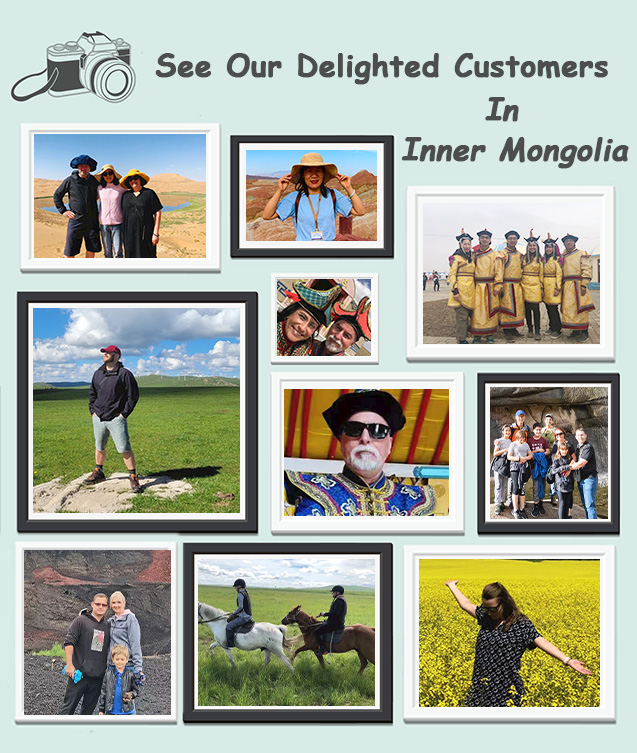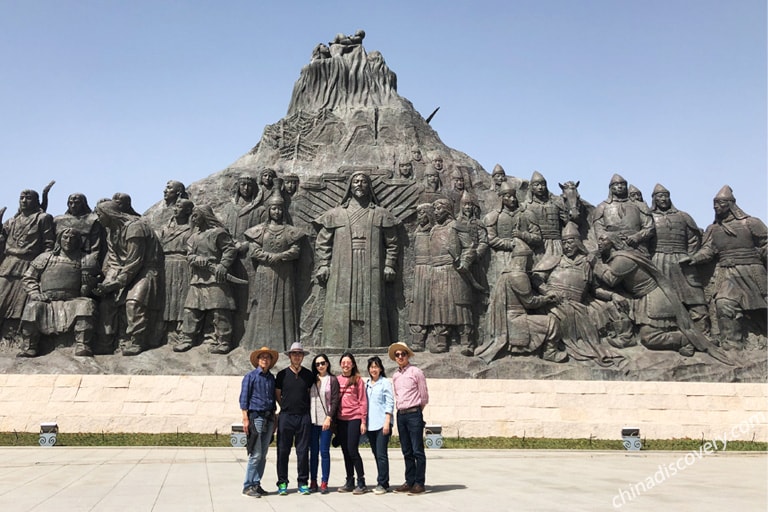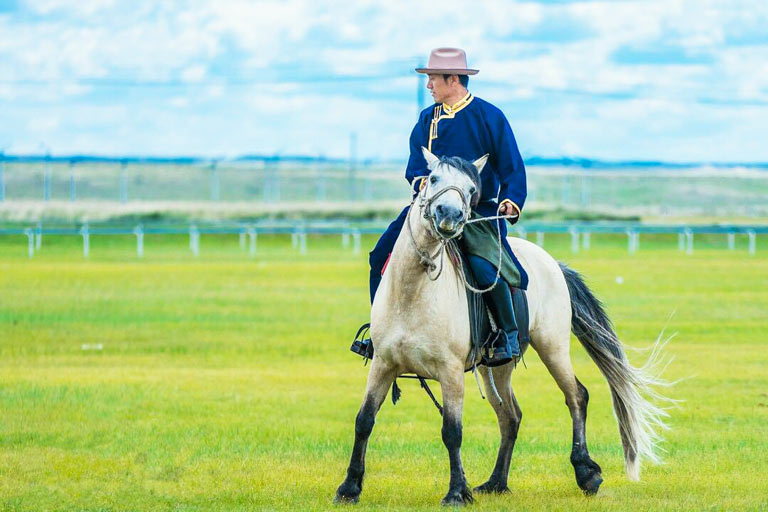Why Visit the Site of Xanadu?
The Site of Xanadu (元上都遗址), the birthplace and the former capital of the Yuan Dynasty, is adjacent to the Shangdu River in the south and Longgang Mountain in the north, surrounded by the vast Jinlianchuan Grassland, forming a layered and radial distribution with the palace ruins as the center. The well-preserved city wall, orderly and symmetrical streets, well-scattered architectural relics, numerous cultural relics and beautiful ecological environment constitute the most well-preserved large-scale ancient capital ruins in China. Historians have praised the ruins of the capital as comparable to the ancient Italian city of Pompeii. There are not only palaces and temples with civil structure, but also the nomadic traditional yurt-style architecture, which embodies the grand style of a highly prosperous prairie capital. The site combines Mongolian culture with Chinese civilization and records an important civilization stage in human history. It’s an outstanding example of the fusion of farming civilization and nomadic civilization.
Built in 1256 by Kublai Khan, the Emperor of the Yuan Dynasty, the Shangdu of the Yuan Dynasty (1271 ~ 1368 AD) covers an area of 25,000 hectares. The capital was square in shape with three layers, the outer layer, the imperial layer and the palace. For over a hundred years between the 13th and 14th centuries, it was the political, military, economic and cultural center of the Yuan Dynasty, and also a summer palace and resort for the royal family. According to Marco Polo's travel notes, in the Site of Xanadu, there was a "beautiful marble palace painted with gold and decorated with carved birds, animals, flowers and trees, showing excellent and delectable craftsmanship."
World Heritage Committee Evaluation about the Site of Xanadu:
“North of the Great Wall, the Site of Xanadu encompasses the remains of Kublai Khan's legendary capital city, designed by the Mongol ruler's Chinese advisor Liu Bingzhdong in 1256. Over a surface area of 25.000 ha, the site was a unique attempt to assimilate the nomadic Mongolian and Han Chinese cultures. From this base, Kublai Khan established the Yuan dynasty that ruled China over a century, extending its boundaries across Asia. The religious debate that took place here resulted in the dissemination of Tibetan Buddhism over north-east Asia, a cultural and religious tradition still practised in many areas today. The site was planned according to traditional Chinese feng shui in relation to the nearby mountains and rivers. It features the remains of the city, including temples, palaces, tombs, nomadic encampments and the Tiefan'gang Canal, along with other waterworks.”
 Site of Xanadu
Site of Xanadu
Historical Relics in the Site of Xanadu
The layout of the Site of Xanadu is stratified and radially distributed with the palace ruins as the center. It is divided into the palace city, imperial city and outer city, surrounded by mountains in the north and facing the river in the south.
The Outer City (外城)
The Outer and the Imperial Cities were the residences of the officials and civilians. The outer city is in the shape of a curve and is expanded around the west and north of the Imperial City. The west and north walls are around 2,220 meters long, the east wall is around 815 meters long, and the south wall is around 820 meters long. Covering an area of about 290 hectares, the remaining wall is 10 meters wide at the base, 2 meters wide at the top and 3~6 meters high. The ramparts are rammed with loess. The rammed walls are about 20 centimeters thick, uneven in thickness. The degree of compaction is not as strong as that of the imperial city, and there is no masonry on the exterior. There are overall 4 gates at the Outer City, one on the south wall, one on the west wall and two on the north wall. The outer city is surrounded by the remains of a moat.
The Imperial City (皇城)
The plan of the Imperial City is nearly square. Covering an area of about 164 hectares, the height is about 6~7 meters, the wall base is 12 meters wide, the top width is about 5 meters, taper upward. The outside of the four walls are built with horse faces, 6 for each wall, a total of 24. The bottom of the stone wall is dug with a base groove and a sloping wall base. There are 6 gates at the Imperial City, two gates in the middle of the north and south walls. The east and west walls of the imperial city are symmetrical and open two doors respectively. There are obvious river traces outside the west wall of the imperial city and the west side of the north wall of the gate of barbican.
The Palace City (宫城)
The Palace City is the most important part of the whole building group. It was the summer residence of emperors and their empresses. The Palace City is also nearly square in plan. Covering an area of about 32 hectares, there are rammed earth walls of different heights on each side, with a maximum of 5 meters, a base width of 10 meters and a top width of 5 meters. The wall is covered with black brick, and the bottom of the brick wall is padded with stone strips or schist as the foundation. There are 3 city gates on the east, west, south wall. There is a closed trench dug outside the gate.
Tiefangan Canal (铁藩竿渠)
When Liu Bingzhong first built the Capital here, he set up iron streamer rods on the hills to keep water down because of the numerous marshes on the land. The hill on which the robs stands is called the Tiefangan Mountain. To safeguard the capital, Guo Shoujing, a famous scientist of the Yuan Dynasty, designed and built the Tiefangan Canal in 1298. The ditch is about 50 meters wide, 2~5 meters high and nearly 6 kilometers long, bend southeast at 450 meters outside the west gate of the outer city and turn south into the Lightning River (闪电河) on the north side of Xiguan Avenue.
 The Lightning River
The Lightning River
Tomb Groups
There are overall 26 tombs that have been excavated in and around the Site of Xanadu, 19 of which have no graves. They are all earth pit tombs with long trapezoidal plans, and the tombs vary greatly in size. The direction of the tomb is mostly northwest. The type of burial is unclear because of the grave robbing in the early stage. The main burial groups worth visiting are the Zhenzishan Tomb Group (砧子山墓葬群) and Yikeshu Tomb Group (一棵树墓葬群).
 Zhenzishan Tomb Group
Zhenzishan Tomb Group
Attractions & Highlights in Site of Xanadu
The Imperial City - Mingde Gate
The Gate of Mingde (明德门) is the first gate to enter the Site of Xanadu from the imperial road. Located on the north-south axis between the imperial city and the palace city, Mingde Gate is the main south gate of the imperial city. The total length of the gateway is about 24 meters and the width is 5~6 meters. Both sides of the walls are covered with black bricks. The top of the gate had already collapsed, leaving the ruins of the collapsed city gate, about 7 meters high. A barbican is set outside the gate, the doorway of the barbican is around 12 meters long, 3.5~3.8 meters wide with a stone pillar standing in the center, that is, the General Stone. There are also stone thin columns and wooden doorpost cornerstones and other sites on both sides of the doorway.
The Palace City - Yutian Gate
The Yutian Gate (御天门) is the south gate of the Palace City, also located on the north-south axis of the Imperial City and the Palace City. It was the place where all the officials gathered together to receive orders and to hear proclamations. A poetry from the Yuan Dynasty had done such a depiction of "Millions of rides pass the Mingde Gate, and hundreds of officials gather under Yutian Gate". The doorways were built by piling up bricks, stones and earth. Outside the gate sets a 60 meters wide and 27 meters long barbican. According to the archaeological excavations, there are two rows of building sites outside the east and west sides of the barbican, which are speculated to be the resting places of the officials before they go to court or when they wait for a decree.
The Palace City - Da’an Pavilion
In the Yuan Dynasty, Da'an Pavilion (大安阁) was used as the "main hall" of the palace city. It’s the place where emperors of the Yuan Dynasty held important political ceremonies, such as the enthronement of the emperor and the reception of foreign ambassadors. Besides, daily activities such as daily court, political consultation, Buddhist practices, and meetings with ministers were also held here. Many important events with worldwide or regional influence took place here, such as the enthronments of emperors of the Yuan Dynasty, Kublai Khan's meeting with Marco Polo and so on.
The Palace City - Muqing Pavilion
Located in the middle of the north wall of Palace City, the Muqing Pavilion (穆清阁) is the largest building in Palace City. It is the large inner palace where the emperor used for entertainment, deliberation and residence. With a total area of 9,180 square meters. The platform plane is a "concave (凹 in Chinese)" shape with the main hall and the east and west wings of the side halls built on it. The halls are mainly palace style architecture.
Bronze Status of Kublai Khan
The Bronze Statues of Kublai Khan (忽必烈铜雕像), about 7.5 meters high, 34 meters long, 6 meters thick and weighing a total of 80 tons, were cast in 2007, symbolizing the 750-year history of the site, the 80-year-old Kublai Khan who reigned the Yuan Dynasty for 34 years and the other six emperors on the throne of the Yuan Dynasty. This statue is beautiful in shape and rich in content. It is a condensed picture of the grand achievement of Kublai Khan's life, which was the lifetime conquest, rule and govern the world.
Xanadu Sites Museum
The Xanadu Sites Museum (元上都遗址博物馆) is located at the foot of Wulandai Aobao in the southwest of the site. There are 4 exhibition areas in the museum, which are Uncovering the Dusty Memory, Searching for the Charm of the Past, Appreciating the Prosperity of Science and Culture, and Imperial Products for the Royal Family of the Yuan Dynasty. In the exhibits, there are relics unearthed from the site of Xanadu, the sacrificial site of the Sheep Temple, and the tomb of Zhenzi Mountain. Even though the number of unearthed cultural relics is not very large, it still shows visitors the glory past of the Yuan Dynasty.
Jinlianchuan Grassland
Every summer, Jinlianchuan Grassland (金莲川草原) is full of golden lotus flowers, looking like a golden ocean, stretching on both sides of the Shangdu River in the upper reaches of the Luanhe River, 60 kilometers from east to west, with the Site of Xanadu as the widest point, about 5~6 kilometers. Jinlianchuan Grassland is rich in wildlife resources. It is not only a natural pasture with crystal clear water and beautiful emerald grass, but also a fun place for horseback riding, hunting, and cool summer escaping. It used to be a summer resort for the emperors of the Liao, Jin and Yuan dynasties.
 Mingde Gate
Mingde Gate
 Barbican of Yutian Gate
Barbican of Yutian Gate
 Da'an Pavilion
Da'an Pavilion
 Muqing Pavilion
Muqing Pavilion
 Bronze Status of Kublai Khan
Bronze Status of Kublai Khan
 Xanadu Sites Museum
Xanadu Sites Museum
 Jinlianchuan Grassland
Jinlianchuan Grassland
How to Get to and around Site of Xanadu
The Site of Xanadu is in the territory of Zhenglan Banner of Xilin Gol League, northwest of Duolun County and along the Lightning River. It’s about 240 km away from Xilinhot city (about 3 hours by car), about 400 km away from Hohhot (7-7.5 hours by car) and about 200 km from Zhangjiakou city (3.5~4 hours by car).
There are no direct flights and trains to the scenic area. So the most convenient and comfortable way to get there, to explore the site of Xanadu and surrounding highlights, is by booking private car services. We China Discovery can take you to the Site of Xanadu and can also help you to arrange transportation and accommodation. If you are interested, please book a private tour package with us which covers sightseeing, dining and transfer, etc. Our local tour guide and driver will take care of all the details!
Get to Site of Xanadu by Train+Car Transfer
Address of Sanggendalai Railway Station: Sanggendalai Town, Zhenglan Banner, Xilingol League (锡林郭勒盟正蓝旗桑根达来镇)
The nearest train station to the Site of Xanadu is the Sanggendalai Railway Station (桑根达来站), which is about 40 km northwest from the scenic area. There are normal trains from Hohhot, Baotou, Ulanhot, Hailar, Tongliao, Xilinhot, Chifeng, Changchun, Harbin, etc. that would make a stop at the railway station. After getting off the train, it still takes almost 1 hour to reach the scenic area of the Site of Xanadu.
Get to Site of Xanadu by Flight+Car Transfer
Address of Xilinhot Airport: West Airport Road, Xilinhot City, Xilingol League (锡林郭勒盟锡林浩特市西部机场路)
Xilinhot Airport (锡林浩特机场) is the nearest airport to the Site of Xanadu. It’s about 10 km away from the downtown area of Xilinhot city. There are no public buses connecting the airport with the Site of Xanadu. Therefore, the only way to reach the scenic area after getting off the plane is by taking a private car. The driving distance between the airport and the site is about 220 km, which takes about 2.5 hours by car. Feel free to contact us to book a tour to the Site of Xanadu with private car services.
 Local Private Transfer Service
Local Private Transfer Service
 Sanggendalai Railway Station
Sanggendalai Railway Station
 Xilingol Airport
Xilingol Airport
More Travel Tips of Site of Xanadu
1. Weather & Best Time to Visit:The Site of Xanadu belongs to a semi-arid continental climate in the middle temperate zone, with an annual average temperature of 1.5℃, -17.8℃ in the coldest month (January) and 18.7℃ in the hottest month (July). The average annual precipitation is over 350 mm, mainly concentrated in summer from June to August, accounting for about 67% of the total annual precipitation. Summer, when the ground is overgrown with weeds and full of golden flowers, is the best time to visit the Site of Xanadu. It is easier to identify the site in its entirety. Tourists are recommended to bring sunscreen and anti-mosquito medicine when visiting here in summer.
2. Ticket & Opening Time: The entrance ticket for the Site of Xanadu is CNY 50/person and the opening time is 8:00~17:00 all year around.
 Golden Flowers Blooming on Jinlianchuan Grassland in Summer
Golden Flowers Blooming on Jinlianchuan Grassland in Summer
How to Plan a Xilingol Tour?
Usually, you can spend 4~7 days around to explore Xilingol. The tour usually starts from Xilin Hot, the league center of Xilingol. During the trip, you can spend 4~5 days to visit the highlights near Xilin Hot (like Xilingol Grassland Volcanic Geopark), in Left Ujumuqin Banner (like The Mongol Khan City and Ujumuqin Grassland), in East Ujumuqin Banner (Wulagai Grassland). Adding 1~2 days to visit Site of Xanadu - the UNESCO World Heritage Site and Jinlianchuan Grassland in Zhenglan Banner is also popular.
☛ 5 Days Primitive Inner Mongolia Tour to Xilingol (Xilingol)
If you have more days in Inner Mongolia, you can transfer to Hohhot, and spend 2~3 days visiting the amazing nearby deserts, Buddhist temples, museums and more essences around Baotou, Ulanqab and Ordos. Besides, you can spend 3~5 days in Chifeng visiting the splendid Hexigten Global Geopark and more wonderful lakes, prairies, etc.
☛ 5 Days Classic Inner Mongolia Tour (Hohhot / Huitengxile Grassland / Kubuqi Desert / Ordos)
☛ 6 Days Inner Mongolia Bests Discovery Tour (Hohhot / Ulanqab / Huitengxile Grassland / Baotou / Kubuqi Desert / Ordos)
☛ 6 Days Inner Mongolia Authentic Nature & Dynasties Culture Tour from Chengde (Xilingol - Chifeng)
Have more days and want more wonders? You can extend your trip to Hulunbuir, Arxan, Greater Khingan, Badain Jaran, Ejina, etc. Also, it is a great idea to travel to more popular destinations in China, such as Chengde, Beijing, Shanghai, Xian, Chengdu, Guilin, Silk Road, Tibet, Yangtze River, etc. You can contact us to customize a Xilingol tour with more personal experiences based on your interests, needs and budget!
☛ 5 Days Best Hulunbuir Tour with Grassland Exploration (Hulunbuir)
☛ 9 Days Hulunbuir In-depth Tour with Arxan UNESCO Global Geopark (Hailar - Ergun - Manzhouli - Arxan - Hailar)
☛ 5 Days Zhangye Danxia Badain Jaran Desert Geography Miracle Tour
Travel Xilingol with China Discovery
Looking for a Xilingol tour but feel hard to arrange your day by day itinerary and site to site transportation? Travel with us China Discovery and let our experienced travel consultant help you. We know Xilingol and Xilingol Grassland much and we have helped numerous visitors to enjoy a tour there. If you go with us, we will customize an Xilingol Tour for you! Your guide will accompany you all the way and show you the best viewing and photography spots. And your driver will take you to cross the grassland along the driving road in the middle of the grassland.
The tour is tailor-made according to your interests, budget, group size and every special need! If you are interested, please feel free to contact us!
 Local Private Transfer Service
Local Private Transfer Service
- 5 Days Primitive Inner Mongolia Tour to Xilingol
- 6 Days Inner Mongolia Authentic Nature & Dynasties Culture
Xilingol Tours
Xilingol Travel Guide
- Popular Xilingol Tours
- Top Attractions
- Xilingol Grassland
- Get to Xilingol
- Weather & Best Time
- Xilingol Where to Stay
- Xilingol Maps
More about Inner Mongolia Travel Guide
- Popular Inner Mongolia Tours
- Inner Mongolia Travel Guide
- Top Cities & Destinations
- Hot Attractions
- Things to Do
- Famous Grasslands
- Top Deserts
- Transportation
- Weather & Best Time
- Hotels & Where to Stay
- Maps
- Photos & Landscpaes
- Travel Tips
- Foods
- Naadam Festival
- Horse Riding
- Mongolian Yurts
- Inner Mongolia Tour Plan
Recommended Tours
Top 3 tours chosen by most customers to explore in the best way. Check the detailed itinerary, or tailor your own trip now with us.

4 Days Inner Mongolia Grassland & Genghis Khan Culture Tour
Hohhot / Huitengxile Grassland / Ordos

6 Days Inner Mongolia Bests Discovery Tour
Hohhot / Ulanqab / Huitengxile Grassland / Hohhot / Baotou / Yemingsha of Kubuqi Desert / Ordos

5 Days Classic Inner Mongolia Tour
Hohhot / Huitengxile Grassland / Yemingsha of Kubuqi Desert / Hohhot
Start planning your tailor-made holiday to China by contacting one of our specialists. Once inquired, you’ll get a response within 0.5~23.5 hours.
Customize a TripHave a question? Get answers from our travel experts or guests
- Your Question:
- Your Name:
- Your Email:
- Submit
























































